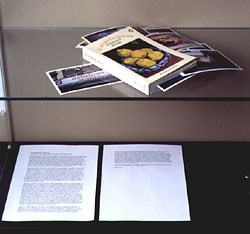 |
Case
Studies
(Landing, a work-in-progress exhibition)
Walk into the entrance lobby of most university geography departments and
you'll see one or two display cabinets. Heavy wooden or metal containers
showing the results of the department's research, their books and papers
are glassed over beyond reach and careful scrutiny. Their display is usually
of a rather muted kind - it's their presence that's important, not the details
of what they hold. They are there to materialise the labour of research,
its productivity, its results, its weightiness, and not its discoveries.
You are meant to notice that the cabinets exist, but not to look at their
contents in any particularly sustained way. All the more so now, since the
assessment of a department's academic output takes place through the quasi-objective
procedures typical of audit culture. The books and papers in academic display
cabinets, never subject to many interested gazes, now languish in even greater
obscurity, relics of another era.
Which
is why, perhaps, many visitors to this exhibition simply did not see it
on their arrival. Its site, in the two display cabinets in the Geography
Department's entrance lobby, did not encourage visibility. White walls,
but no frames, no captions, and too many easy chairs. It didn't look like
an exhibition. But then, nor did it look much like an academic display cabinet
any more. Only one book remained as a forlorn reminder of past use - and
even that was a cookery book, recently elevated to being a fit subject for
geographical research but still not yet acceptable as an output of geographical
work (I await the day). Nonetheless, one has to look at something while
hanging around in a lobby, and these cabinets do exert their own pull. Not
just showcasing the fact of academic labour, the pieces, each occupying
one quarter of a cabinet, engage rather carefully with the processes and
sometimes with the politics of producing and displaying knowledge about
our environments. Unlike the cabinet's brute marking of the output of academic
work, the exhibition focuses on the processes of that labour. A casual glance
at their container thus becomes something more sustained. The actuality
of the cabinets' existence becomes supplemented by their temporary conversion
into a somewhat more reflexive exhibition.
Let's
return to that relic book. It's a dog-eared copy of Elizabeth David's classic
Italian Food. Spilling out of it though are Richard Wentworth's photographs,
brash in their newness and kodak brightness. Phil Crang's text makes this
juxtaposition an invitation to look beyond the conventional and the canon,
beyond the rather tired book, and to see the marginal and its detail as
inventively exciting, 'the peeling paint and the foil' of a take-away shop.
The photos are of cheap cafes and greasy spoons, selling food from many
places and from mass-produced no places, and Crang celebrates the texture
such everyday locales give to our lives. Both the text and the book/ photographs
also entice us to look. There's a suggestion that the visual may be a resource
that academic books are not good at engaging with. If the David stands in
for the ghosts of the books which usually inhabit these cabinets, then the
photographs are the brash newcomers which may startle those books from their
complacency.
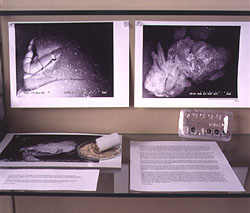 |
The
collaboration between Jeremy Deller, Adrian Palmer and David Gilbert also
considers the relation between the written and the visual. Here we see a
sample of soil brought back from Deller's plot of land in California to
the soil laboratory in the Geography Department, and we see it twice. We
see the sand and grit spilling from a plastic container and we also see
it magnified hugely and photographed. Deller writes a brief caption emphasising
his fascination with his piece of land, but we are left wondering at the
precise nature of that fascination, staring at the soil as if in its nature
it held the answer. The soil is really there, in the cabinet, and its complexity
is described - and description it does indeed seem to be - by the photographs
and their scientific genre. But it does not speak, and so we turn to Gilbert's
essay which seems by contrast so much more informative, not so say seductively
eloquent. We learn about modern tourism, anti-tourism, and hyper-tourism
in a way that renders that soil even less interesting - though no less real.
Here the text serves again to suggest a difference between writing and seeing,
except that this time the text butts up against what is visible, and the
visible soil is all the more intransigent for its silence. What we can see
here, then, is installed more as the limit to what is knowable and less
as a resource for new kinds of knowledge.
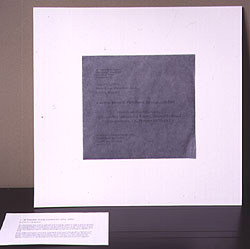 |
Elsewhere
in the cabinet, though, the relationship between seeing, writing and the
environment is approached in rather more complicated ways. In these pieces,
text and vision are less obviously counterposed, and knowledge is made somewhat
more uncertain as a result. Jacqueline Jeffries, in considering the work
of physical geographer Rob Kemp, has produced a piece altogether more enigmatic
about the relation between knowledge and seeing, writing and the earth.
As Jeffries explains, the addresses she has redrawn on paper are the addresses
of soil suppliers. Her own garden's soil has been covered with concrete,
and in buying bags of compost for planting she has found that soil easily
moves. It is transported long distances and, presumably, given the popularity
of gardening now, in huge quantities. Earth then is no longer quite the
stable foundation it sometimes seems. Unlike Deller's soil, though, Jeffries
does not think of hers as mute. Instead, she makes it speak, by mobilising
it to write. For she uses graphite, a rock, to draw the addresses. The addresses
are legible; the earth is made to write and to produce knowledge of itself.
This is not a simple assimilation of the soil into language and knowledge,
however, for Jeffries has also veiled her paper in a very fine network of
lines. The addresses are legible, but from certain angles, only just. They
emerge from the graphite but appear also to be vulnerable and disappearing
back into it. Soil here then sits on the cusp of the visible and invisible,
the knowable and the unknowable.
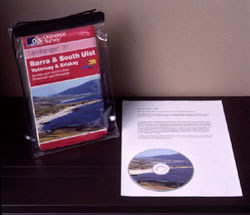 |
One
of the cabinet's quarters appears very much as a geography display might.
An OS map with CD of Barra, in the Outer Hebrides, wrapped in rain-proof
plastic cover, represents a project to be realised after this work-in-progress
exhibition. The map of Barra is here as walking guide and prelude to the
collaboration between Jean-Luc Schwenninger, Matthew Dalziel and Louise
Scullion that explores the traces of long term change in the landscape of
Barra in the field and on film. The map's picture repeated on the CD suggests
the process of seeing and converting this place to map and other forms of
representation.
Kathy
Prendergast's map also hovers on that edge between knowing and unknowing.
At first glance, this is simply a map with the place names changed. Its
layout looks familiar (its base is the eastern seaboard of the United States),
there are lines for roads and rivers and different colours to mark the land's
contours. But the names are new: Hope Hollow, Liberty, Needy Creek, Paradise
Park, Hopeful. This would be enough, since the new place names are wonderfully
evocative of an emotional geography of relationship, and Catherine Nash
makes a connection to the feelings immigrants to a new land might have.
But the names are repeated many times, sometimes with slight variation -
Paradise, Paradise Park, Paradise Falls, Paradise Creek - suggesting a repetition
of structures of feeling that is at once intensely moving and somewhat banal.
Hope Swamp - my favourite, how marvellous; Hope Fork, Hope Falls, Hope,
Hope, Hope - how unimaginative. But if the repetition problematises the
register in which an emotional state is being named, the map also problematises
the place to which the name is being attached.
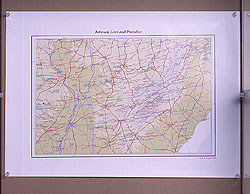 |
Many names have a red dot beside them indicating (you guess) a settlement,
but many do not. They are names that hover, seemingly unattached, over a
blank space in the map. Or the name seems not to correspond to whatever
features the map does show: Dams and Creeks have no water nearby, Hills
have no high land indicated. Then again, other features on the map are unnamed:
rivers, roads. And the map lacks those fundamental signs of accuracy that
every schoolchild is taught: a key, a scale and a pointer to north. Here
then, our knowledge of the land this map shows us is quite disorienting.
It is not an objective and accurate map, at least not as we usually understand
that kind of map to be, yet its emotional subjectivity also seems somewhat
unreliable. Most puzzling of all, the relation between name and place is
so uncertain as to suggest, in the end, arbitrariness. Our relation between
ourselves and an environment is rendered uncertain.
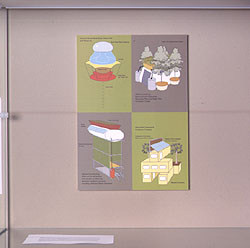 |
Some
elements of this installation explore how and what we can know about environments,
whether that be through writing about them or visualising them. In so doing,
they render the cabinet and its limits problematic. The cabinet obscures
such an exploration in its preference for the display of academic product,
not process. These pieces therefore render the cabinet more like an exhibition
than do some others, I think. Some of the other pieces here prefer to invoke
the weightiness of the cabinet more directly. Nils Norman and Vandana Desai,
for example, do so in their showcasing of designs of objects that could
further sustainable development. Here the academic authority envehicled
in the cabinet is put to use to advocate sustainable architecture. Although
advocacy is certainly a new purpose for the academic display case, it still
has some relation to the authority of the academic expert. So the designs
for an office unit, a work unit and a street water kiosk resonate with applied
relevance; as Desai says, "our main concentration is on the theme of sustainability,
affordability and low cost maintenance for poor people". Yet here too, the
authority is not quite what it seems, the expertise not quite watertight.
For the designs are somewhat whimsical, not only in the idealism of their
politics but also in their technical accomplishment. They carry minimal
technical details - they are ideas visualised not working plans, inspirations
not instructions.
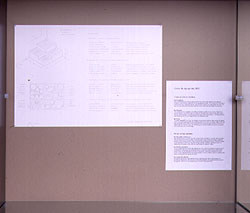 |
Jan
ice
Kerbel and Felicity Callard also use the cabinet to advocate, but also seem
to slip between genres, disconcerting the cabinet's framing. Their plan
for an indoor garden for agoraphobes carries more information and recommendation
than Norman and Desai's diagrams. Kerbel's plans and lists suggest what
plants to use, what their preferred environment is, the size of the garden
area, where to plant what. It's detailed and authoritative, despite its
rather faint execution in pencil. The printed text, though, where Kerbel
and Callard outline the principles underlying the garden, has rather disconcerting
overtones of the garden makeover programme as well as the academic expert
("high ceilings will appear lower if you use hanging baskets, low rooms
will appear higher if you use bold and upright plants"). The notion of a
visit to a garden centre as actual shopping therapy would be whimsical if
it were not the case that the users of these indoor gardens precisely cannot
shop for or in comfort of any kind. The display cabinet as holder of authority
is thus somewhat undermined, both by the reference to other kinds of gardening
and to the impossibility of that reference if the garden were to be created
by those for whom it is intended.
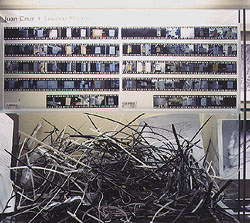 |
The
final installation is from Juan Cruz and Luciana Martins. It is the only
one to directly comment on these cabinets, and does so in its text (print
outs of email correspondence), in its images (included is a 35mm transparency
of the cabinets themselves displayed) and in its installation (the transparencies
are illuminated by the integral toplighting of the cabinet). Many of the
relations to the cabinets to be found in the other installations are reiterated
here. The slides show the notices put in streets when planning permission
to change some aspect of the built environment is sought. Below them, an
untidy pile of cable clips and bits of string have been dumped, it looks
like the means by which the notices were held in place. And being 'in place'
is what this piece explores. As Cruz notes in one of the texts, planning
permissions demonstrate an investment in a place through a desire to change
it. I find this assertion fascinating, since it is so often assumed that
to feel in place is to know it fully and to want it to stay the same. But
the engagement with place through various strategies of change or of not
knowing is a theme of many of these installations. Maps that are uncertain,
earth that moves and is silent and speaks, changing a house where constancy
is valorised (the agrophobe's garden), alterations in what we see in the
everyday, diagrams that don't work - we have seen all these. The mess and
complexity this paradox between knowing and not-knowing a place produces
is materialised in that jumble of cable and string, a jumble which resists
the order of the cabinet, its lines of tidy books and papers, its squareness
and its weight. The cable and string seem to epitomise the way this exhibition
pushes at the boundaries of its display cases, suggesting the possibility
of other ways of knowing.
The supplementarity between the two modalities of this installation - between
the mode of the display cabinet and that of the exhibition - is not resolved
by any of these pieces, then, and is if anything heightened by their juxtaposition.
The careful scrutiny invited by the exhibition vies with the authority of
the display cabinet, and each piece negotiates this relation in its own
way. Even those that do not refer directly to academic modes of display
still make use of the glass and the frame to articulate the gaze of their
spectators. In the end, then, what this exhibition suggests - and this is
salutary to those in the social sciences who wish to rush headlong into
visual arts as if they offered an answer to what seems increasingly like
the dead end of representational theory - is that both these modalities
rely on quite particular modes of address but that make a demand that is
both authoritative and productive. The exhibition demands its own way of
seeing, just as much as the display cabinet. Its focus may be different
but its power is not.
Gillian Rose |








